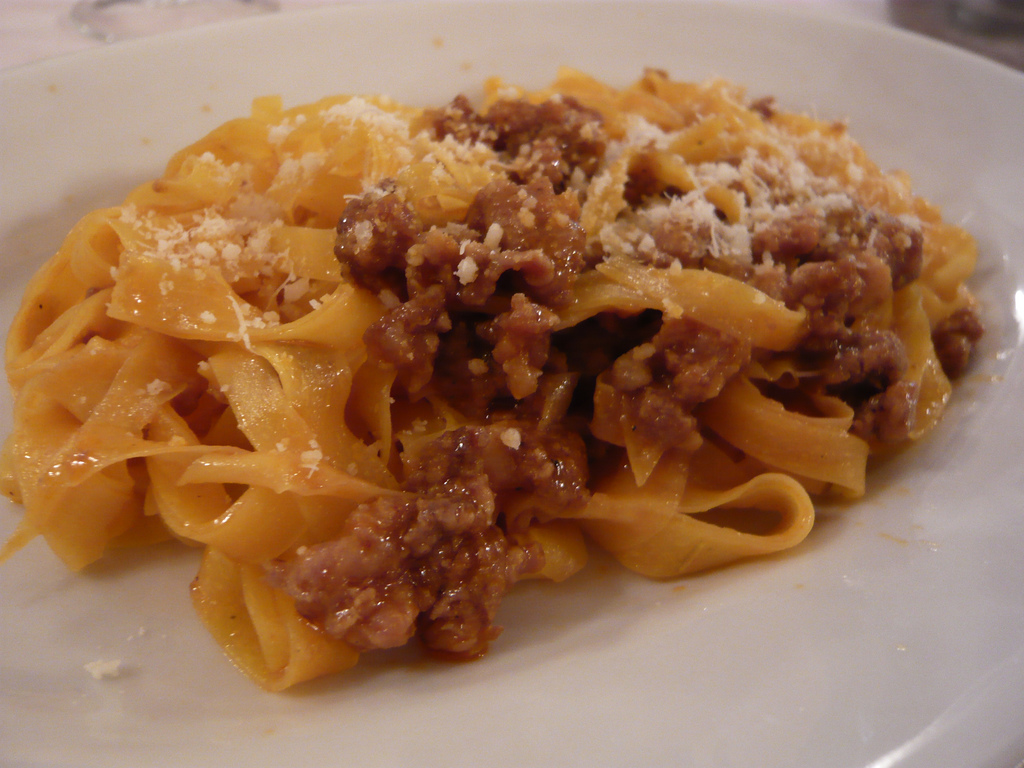Food
A Culinary Trip Through Bologna: A Foodie’s Dream

Photo credit: WordRidden (cc)
Lamborghini. Ferrari. Ducati. Pavarotti.
Besides being among the best in the world for cars, motorcycles and opera, what do these names have in common? They each originated in Italy’s Emilia-Romana region — also home to one of the most celebrated food capitals of the world.
No other country has captured the culinary imagination like Italy — and no other city is devoted to gastronomic excellence than Bologna. While nearby Florence receives a lot of attention for its history and art, the less-touristy Bologna is a foodie’s dream. Visitors stroll the streets lined with distinctive red-roofed buildings housing everything from legendary eateries to shops offering cured meats, colorful produce and fresh pasta, as well as cooking schools where even novice chefs can try their hand at creating the city’s signature dishes.
With so much amazing food to choose from, the most difficult part of exploring Bologna’s culinary paradise is knowing where to start.
Bolognese Specialties
While some visitors may use “Italian food” as an umbrella category, including all food from Italy, there are distinct regional differences in the cuisine. From the simple, seafood-heavy dishes of Sicily to the heavier dishes of northern Italy, which often feature red meats and more substantial vegetables like carrots and cauliflower, the food of Italy is as diverse as the landscape.
Unlike the food of southern Italy, which is influenced by the Mediterranean region, Bolognese food leans more on French influences. This results in sophisticated, rich dishes that are subtle and delicate. Cured pork and cheeses are the hallmarks of Bolognese cuisine; expect to find the markets and menus full of prosciutto, mortadella and salami, as well as fresh, locally produced Parmigiano-Reggiano cheese.
Perhaps the most well-known Bolognese specialty is ragu Bolognese, or Bolognese sauce. This meat-based sauce is made from finely chopped beef cooked with carrots, onions and celery, wine and tomato paste or concentrate, slow-cooked for several hours. The sauce is most commonly enjoyed with lasagna or tagliatelle pasta, both of which originated in the region.
Restaurants
Since eating is one of the Bologna’s greatest pleasures — and the reason many visitors make the trip — it should be no surprise that the city is dotted with some of the world’s best restaurants.
Locals have flocked to Ristorante Diana for nearly a century, drawn by the elegant décor, service and game-heavy menu. Diana is also known for its spuma di mortadella, a pâté made from pureed mortadella sausage.
Ristorante al Papagallo is rated among the best of Bologna’s dining spots by several sources. Make a reservation here to enjoy traditional local specialties, as well as new twists on old favorites, such as rabbit ravioli with smoked ricotta and the papagallo platter, an assortment of fried seafood.
For a bit of literary trivia and excellent wine with your meal, try Franco Rossi. This intimate restaurant features prominently in John Grisham’s novel “The Broker,” but even non-bibliophiles will appreciate the extensive wine list and unique menu items.
Of course, Bologna is more than five-star restaurants and gourmet cuisine. Any number of small cafes and hidden dining rooms offer culinary surprises that could rate among the best meals you’ve ever had. You may find bed and breakfasts in Bologna delighting your senses in ways not possible elsewhere.
Learn To Cook
Bologna is Europe’s oldest student city — the University of Bologna opened its doors in 1088 and has drawn students from all over since — so it makes sense that it’s also home to some of the best cooking schools in Italy.
One of the most popular schools is the International Cooking School of Italian Food and Wine. Established by noted chef and author Mary Beth Clark, the school offers week-long cooking classes in several subjects, including the basics of Italian cooking and pizza. Students shop for ingredients in the local markets, learning how to choose only the finest produce and meats. Then, under the tutelage of renowned chefs, they learn to transform those ingredients into delicious meals.
For those looking for a less-intense experience, the Bologna Cooking School has half and full-day workshops. Held in the kitchen of a real Bolognese home, and taught by local home cooks, these workshops can be tailored to your own tastes and interests, but focus on the local specialties of fresh-egg pasta (including lasagna, tortelloni, tortellini and tagliatelle), and Bolognese sauce. These classes include tastings of other regional specialties, including parmesan-reggiano and balsamic vinegar.
Even those who don’t consider themselves “foodies” will delight in the Bologna’s food and wine. After a few days here, you may never look at simple spaghetti and meatballs the same way again.
If there is one thing that blogger Frances Masterson loves, it’s eating. While these days most of her cooking takes place in her suburban kitchen and focuses on kid-friendly food, she hopes to one day head to Italy and perfect her Bolognese sauce.


















Emilia Delizia
March 17, 2013 at 10:11 am
I love any article about Bologna, thank you for sharing this. Just to be precise Pavarotti and Ferrari are from Modena.